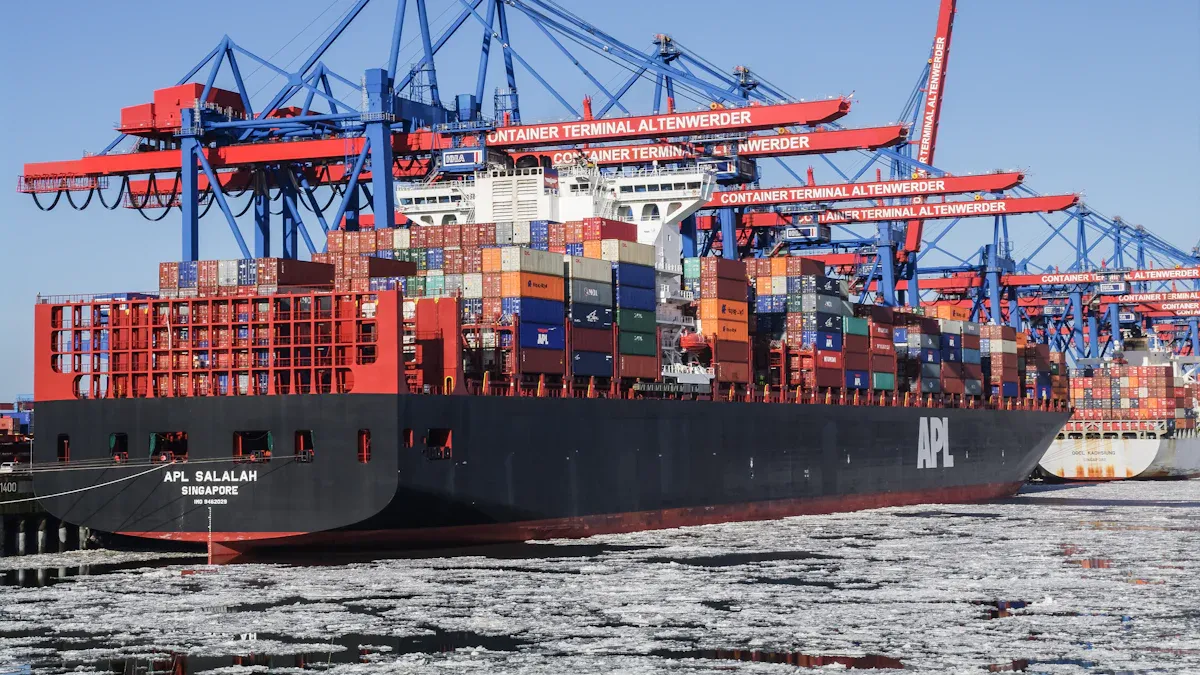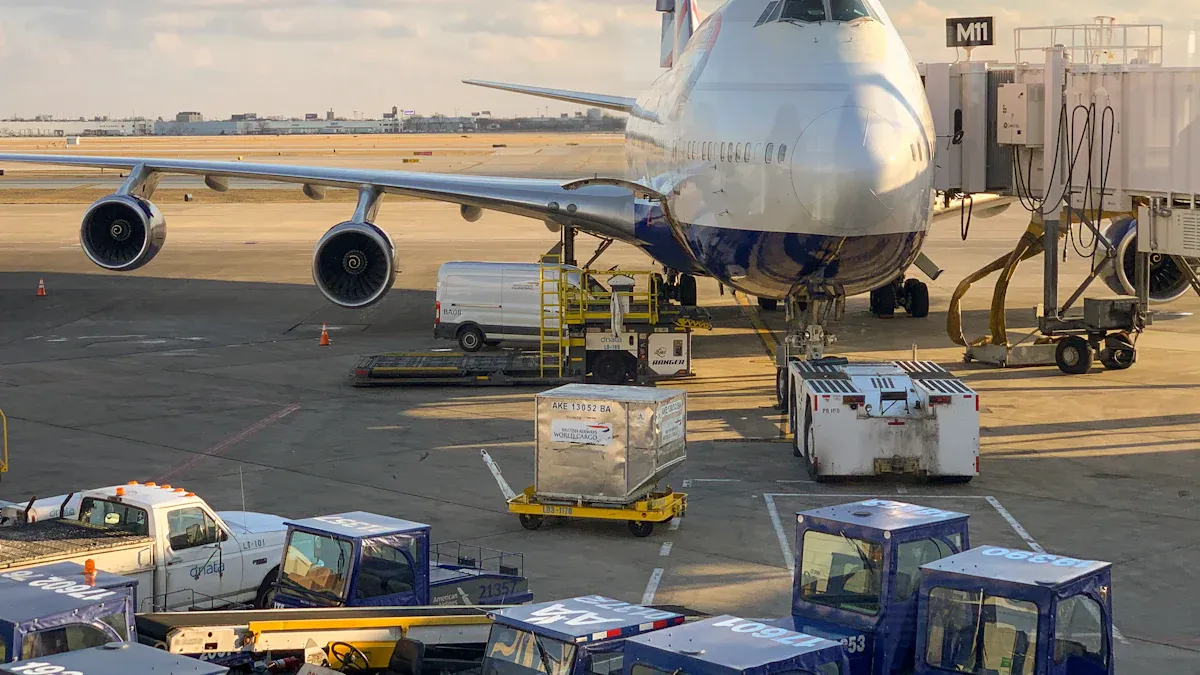Cross-Border Logistics and Air Freight Price Volatility

Air freight price volatility poses a critical challenge for cross-border logistics, influencing costs and operational efficiency. Recent disruptions, such as the Covid-19 pandemic and geopolitical tensions, have amplified this issue, often outweighing traditional supply-demand dynamics. High and fluctuating fuel prices further exacerbate the problem, driving up operational costs. The air cargo market, projected to grow significantly due to e-commerce, underscores the importance of addressing this volatility. Despite an average annual growth rate of 2.6% over two decades, the sector’s resilience continues to be tested by unpredictable pricing trends.
Challenges for Small and Medium-Sized Enterprises (SMEs)
Small and medium-sized enterprises (SMEs) face unique challenges in managing air freight price volatility. Unlike larger corporations, SMEs often lack the financial resources and logistical infrastructure to absorb sudden cost increases or adapt to market fluctuations. This limitation places significant pressure on their operations and profitability.
One major challenge for SMEs is the unpredictability of transportation costs. Air freight price spikes can strain their budgets, forcing them to either pass costs onto customers or absorb losses. For example, during peak seasons, SMEs may struggle to compete for limited cargo space, as larger companies often secure priority access through long-term contracts.
Note: SMEs typically rely on spot market rates for air freight, which are more susceptible to price swings than contracted rates.
Limited access to advanced logistics tools further complicates the situation. Many SMEs lack real-time visibility into shipping costs and capacity, making it difficult to plan shipments efficiently. Without predictive analytics or digital platforms, they cannot anticipate price changes or optimize routes, leading to inefficiencies and higher expenses.
Regional variations in freight pricing also create obstacles. SMEs operating in multiple markets must navigate differing cost structures, which can disrupt their supply chains. For instance, overcapacity on trans-Pacific routes may lower rates, while shortages on other routes drive prices higher. These disparities make it challenging for SMEs to maintain consistent pricing and delivery timelines.
Finally, compliance with international trade regulations adds another layer of complexity. SMEs often lack the expertise to manage customs requirements, which can lead to delays and additional costs. This issue becomes more pronounced when air freight prices fluctuate, as businesses must quickly adapt to changing conditions while ensuring compliance.
Addressing these challenges requires SMEs to adopt innovative strategies. Leveraging digital tools, partnering with experienced freight brokers, and exploring multimodal transport options can help them navigate the complexities of cross-border logistics.
Strategies to Manage Cross-Border Logistics Challenges
Leveraging Digital Tools for Real-Time Visibility
Digital tools have revolutionized how businesses manage cross-border logistics. Real-time visibility has become essential for tracking shipments and monitoring conditions to prevent disruptions. Integrated tracking systems, blockchain, and predictive analytics are among the most effective tools. These technologies provide accurate, up-to-date information, enabling businesses to respond quickly to potential issues.
Supply chain visibility is particularly crucial for industries that rely on speed and precision. For example, predictive analytics uses AI algorithms to analyze historical data and market trends. This approach forecasts potential shipping challenges, allowing companies to plan proactively. Intelligent routing platforms further enhance efficiency by suggesting optimal shipping routes based on real-time data. These tools reduce delays and minimize costs, ensuring smoother operations.
Strategy | Description |
|---|---|
Predictive Analytics | AI algorithms analyze historical data and market trends to forecast potential shipping challenges and opportunities. |
Intelligent Routing | The platform suggests optimal shipping routes based on real-time data, helping businesses avoid delays and reduce costs. |
Automated Decision-Making | AI-powered systems can make split-second decisions on shipping options, ensuring businesses always get the best available rates. |
Continuous Learning | AI systems continuously learn from new data, improving their accuracy and effectiveness over time. |
Adopting Multimodal Transport Solutions
Multimodal transport solutions combine different modes of transportation, such as air, sea, and land, to optimize logistics strategies. This approach offers flexibility, allowing businesses to adapt to fluctuating air freight prices. For instance, companies can shift to sea freight during periods of high air cargo rates, reducing costs while maintaining efficiency.
Diversifying supply chains through multimodal transport also mitigates risks. Using multiple carriers for various routes ensures consistent service levels and prevents disruptions caused by capacity shortages. Additionally, technology-driven tools help businesses navigate foreign exchange (FX) challenges, protecting their bottom lines. Ongoing transaction cost analysis (TCA) further enhances performance by ensuring consistent FX execution.
Strategy | Description |
|---|---|
Technology-driven tools | Helps companies navigate FX challenges and protect their bottom lines. |
Transaction cost analysis (TCA) | Ongoing TCA can ensure consistent FX execution performance. |
Diversifying supply chains | Using different carriers for various routes can optimize rates and service levels. |
Partnering with Experienced Freight Brokers
Experienced freight brokers play a vital role in managing cross-border logistics challenges. They offer expertise in navigating complex shipping regulations and securing competitive rates. For small and medium-sized enterprises (SMEs), partnering with brokers can provide access to resources and networks typically unavailable to smaller businesses.
Case studies highlight the benefits of these partnerships. Alcatel-Lucent collaborated with nVision Global in 2006, leveraging freight audit and payment solutions to enhance supply chain efficiency. This partnership resulted in significant cost savings and actionable business intelligence. Similarly, Teradyne utilized nVision's solutions to streamline logistics and reduce expenses, gaining a competitive edge in the market.
Tip: Building strong relationships with freight brokers can lead to better-negotiated rates and improved transparency in logistics operations.
Building Flexible and Resilient Supply Chains
Building flexible and resilient supply chains is essential for mitigating the impacts of air freight price volatility. Companies that adopt these strategies can better navigate disruptions and maintain operational efficiency. Flexibility allows businesses to adapt quickly to market changes, while resilience ensures long-term stability in the face of external pressures.
“This flexibility has enabled us to quickly adapt to market changes and deliver tailored solutions, while strengthening our collaborations to create long-term value,” M. Yassine Berrada, Vice President of Cargo at Royal Air Maroc, explained.
Resilient supply chains often incorporate advanced technologies and strategic planning. Global industrial manufacturing and construction companies, for example, employ resilience strategies such as overbuying critical materials and leveraging predictive analytics. These measures help mitigate production delays and enhance supply chain value. By adopting similar approaches, businesses can reduce their dependence on volatile air freight markets.
The aviation industry remains particularly vulnerable to geopolitical tensions, which frequently disrupt supply chains. Resilient supply chains can adapt to these challenges by diversifying transportation modes and sourcing options. For instance, companies can shift from air freight to sea or rail transport during periods of high price volatility. This diversification minimizes risks and ensures consistent delivery timelines.
Key strategies for building resilient supply chains include:
Investing in advanced technologies like AI and blockchain for real-time visibility.
Establishing strong partnerships with logistics providers to secure capacity.
Diversifying sourcing and transportation options to reduce dependency on a single mode.
These strategies not only mitigate the effects of air freight price fluctuations but also enhance overall supply chain performance. Businesses that prioritize flexibility and resilience can maintain a competitive edge, even in volatile markets.
Emerging Trends and Technologies to Mitigate Volatility

The Role of Overseas Warehousing in Cross-Border Logistics
Cost Optimization Through Bulk Shipping
Overseas warehousing offers significant cost advantages by enabling bulk shipping. Consolidating shipments reduces transportation expenses and maximizes delivery efficiency. For example, companies like Walmart combine multiple products into single shipments, optimizing routes and lowering fuel consumption. Logistics providers also negotiate better rates and implement advanced technologies to streamline operations, further enhancing cost savings.
A comparison of traditional shipping models and overseas warehousing highlights these benefits:
Metric | Traditional Model | Overseas Warehouse |
|---|---|---|
Average Shipping Cost | $8.50/unit | $3.20/unit |
Customs Clearance Time | 5.8 days | 1.2 days |
Return Rate Impact | 23% | 11% |
Additionally, businesses using overseas warehouses experience an 89% faster time-to-market for new regions, a 47% increase in cross-border conversion rates, and a 34% improvement in localized customer experiences. These metrics underscore the transformative impact of bulk shipping on cost optimization.
Enhanced Delivery Efficiency and Customer Satisfaction
Proximity to end markets significantly improves delivery efficiency. Overseas warehouses enable faster last-mile delivery, reducing transit times and enhancing customer satisfaction. For instance, warehouses in Los Angeles achieve delivery within 1–3 days for local orders, compared to 10–15 days for direct cross-border shipping. This speed not only meets consumer expectations but also strengthens brand loyalty.
Localized warehousing also simplifies returns processing. Customers benefit from quicker resolutions, while businesses reduce the operational burden of managing international returns. Improved post-purchase experiences contribute to higher satisfaction rates, making overseas warehousing a strategic asset for companies aiming to excel in cross-border logistics.
Reduced Compliance Risks and Customs Challenges
Overseas warehousing minimizes compliance risks by streamlining customs processes. Businesses using digital customs platforms spend 50% less on compliance compared to those relying on manual methods. Additionally, logistics companies adopting digital technologies report a 10–15% improvement in operational efficiency, including faster processing times and reduced costs.
Partnering with third-party logistics (3PL) providers further simplifies global trade. These providers leverage their expertise in customs regulations to ensure smooth operations, reducing delays and disruptions. Bulk customs clearance, often associated with overseas warehousing, faces lower scrutiny than small-parcel shipments, further mitigating compliance risks. This approach allows businesses to focus on growth while navigating the complexities of cross-border logistics with ease.
Air freight price volatility stems from several factors, including fuel costs, capacity-demand imbalances, geopolitical disruptions, currency fluctuations, and environmental regulations. These elements collectively challenge cross-border logistics by increasing costs, causing delays, and complicating supply chain management. For instance, fuel costs, which account for 25-35% of operational expenses, significantly influence pricing. During the pandemic, rates on routes like Shanghai to Los Angeles surged to $14/kg due to capacity constraints.
Businesses can address these challenges by adopting digital tools, multimodal transport solutions, and resilient supply chain strategies. Technologies like AI and blockchain enhance visibility and efficiency, while sustainable practices and autonomous freight solutions reduce costs and environmental impact. By leveraging these innovations, companies can adapt to the dynamic logistics landscape and maintain competitiveness.
Looking ahead, businesses must remain agile and proactive. Monitoring market trends and embracing emerging technologies will be crucial for navigating the complexities of cross-border logistics in an increasingly volatile environment.
See Also
Understanding Logistics Risks: Current Trends and Implications
Managing Supply Chain Challenges Amid Rising Inflation Insights
Addressing Global Supply Chain Growth Issues Effectively
Exploring Supplier Dynamics in International E-commerce Solutions
Transforming Logistics Through Innovative Supply Chain Strategies
